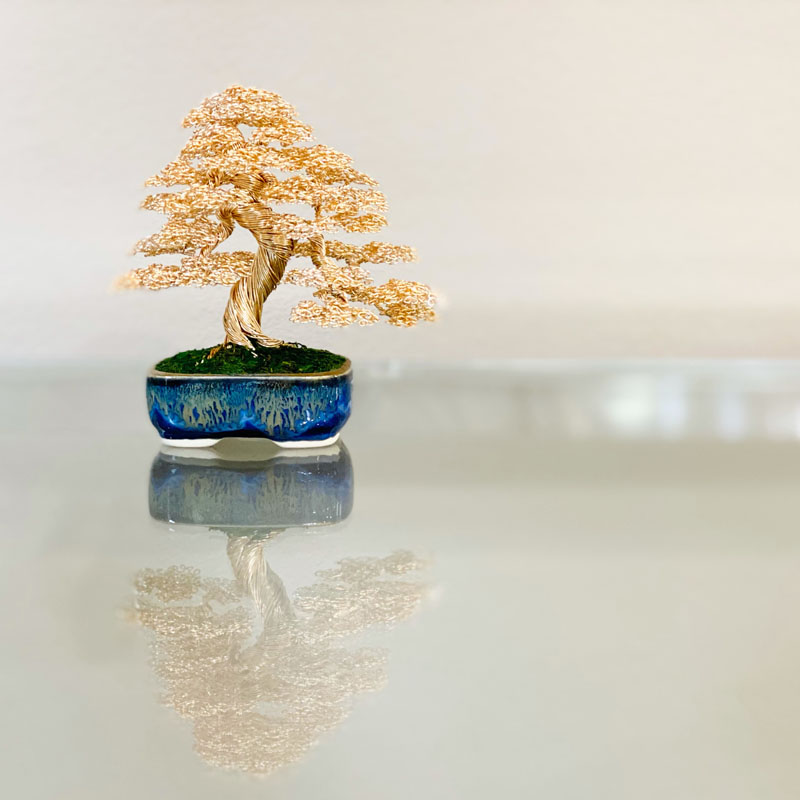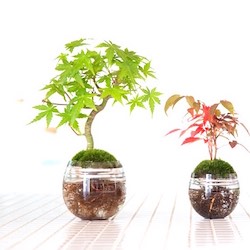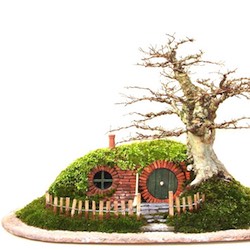Bonsai wire sculptures have been around for a very long time but their recent surge in popularity is largely due social media. Artists and craftsmen all over the world are making and sharing stunning examples of their work online.
Due to the availability of quality examples online, this art form has greatly evolved and improved in recent years and has attracted a lot of new talent; new artists are continually bringing fresh new ideas to the table. In this article we asked two craftsmen, Ken To and Matthew Gollop, to share their experiences with us.

Nice twisting trunk. An informal upright, made with brown and green wire in a Ken To pot.

The foliage is truly realistic. A semi-cascade with twisted trunk. Made with brown wire, the foliage is flocked. This sculpture sits in a Ken To pot.
Ken To: Like everything else, there was a huge learning curve for me. There weren't many tutorials or books available on making wire bonsai at the time. My first tree took about 17 hours to complete, it was a very basic tree that I made for my wife for Christmas. I shared my trees on Facebook in a bonsai group and it caught the eye of Kevin Iris and he commented on my post; then he shared his wire trees and I realized just how amazing these sculptures can be. Needless to say, it was a life changing moment for me.
The sculptures I make now take anywhere from 4 to 30 hours to complete, depending on the size and complexity of each piece. The process begins with deciding what type of tree sculpture to make, then there's the wire selection process, what gauge, what color, copper vs aluminum, what length and etc and ultimately ends with placing the tree in a pot (and some final adjustments).

A raft style sculpture made with silver colored wire. This piece sits in a Jim Barrett pot.

Stunning color and reflection. A larger informal upright. Made with gold colored copper wire and placed in a Ken To pot
How the wire Bonsai sculptures are made
Similar to actual bonsai, the process of making these wire trees begin with the forming of the base; once the base is set, the rest of the tree follows the flow. Next come the primary branches, secondary branches, tertiary, and whatever branches come after them, then foliage is added. The foliage is definitely the most time-consuming part of the process. Each foliage pad requires approximately two minutes to form and adjust; on a basic sculpture with 120 pads, that's at least four hours spent forming and adjusting the foliage pads.
So, once we have all the components of the tree, it's time to shape the tree; this is my favorite part. Again, all work is done from the bottom; that first branch sets the tone and direction of the tree, then the rest of the branches follow suit. Once the tree is complete, we move on to pot selection. Finding the right pot is just as important as making the tree, you can make great looking tree but all that hard work is lost if that tree is ultimately placed in the wrong pot. A wire bonsai is only successful if the tree and pot work together.
Matthew Gollop documented the creation of a Wire Bonsai and with his help we created the following wire bead tree tutorial. Matthew: To make this wire crystal tree sculpture I visualised the tree I wanted to make before starting the assembly. You can get a piece of paper and draw a rough sketch of the wire bead tree you have in mind.
A few stats: The tree is 260mm/ 10″ tall, created from silver coated copper wire, 0.315mm diameter and approximately 190 meters of wire used. Around 700 Lilac Beads were used to create the foliage, 8mm diameter. The base was a real driftwood.

Growing on a rock.
To complete this beginners wire bead tree tutorial you will need to collect together the necessary tools. This includes:
General Tools: A strong metal ruler, goggles, strong metal cutters that are comfortable to use, basing pot or material, glue.
Crystal beads: A These need to have a hole through the beads for inserting your wire. I would recommend getting some 8mm beads like these. It’s really important to purchase the correct number of beads upfront. I would recommend buying more beads than you need. You need 27 beads per tree branch if you follow my method. I recommend about 15 to 20 branches for a medium sized wire tree. So you’ll need between 405 and 540 beads for a medium wire bead tree. Round this number up to 600 and you should be good.

Bright purple wire sculpture.

White and orange Wire Bonsai.
The process of making a Wire Bonsai, step-by-step
Step 1: Sort out your beads and wire first. I use around 22cm for each strand, this doesn’t have to be exact. Make a few slightly longer and a few slightly shorter for a natural look. Measure out the wire before you start and place the beads in a bowl so they don’t get lost everywhere! Cut the required number of wire strands before you start making the bead tree.

Beads and wire.
Step 2: The aim here is to thread the beads on to the wire and create a leaf pattern. There are a wide range of patterns you can choose, my method is based on batches of 3. Take a bead and a single strand of wire. Thread the wire through the bead with a bit poking out of the end; around 2cm but less if you can manage it. Bend the piece of wire which is poking out back over the bead and hold it to the wire on the other side. So you’ve effectively got your bead in a loop of wire. Pinch the base of the wire loop you’ve just made. Then, using your free hand pinch the bead and twist it around so that the wire twists together and secures the bead on to the wire strand. Repeat this process two more times so you now have three strands of wire, each with a bead on the end. Now take these three strands, bunch them together and pinch a few centermiters below the beads. Twist the wire together below where you are pinching it. Leave the last section of wire untwisted – this will form your roots. Once the wire strands are twisted together separate out the beads to form a leaf. You have just made your self a wire twig with bead leaves. Repeat these steps three more times so you have three twigs (which will support have 9 bead leaves). Take your three twigs and twist them together to form a branch. I usually twist two together first then add the third one on a little lower down to make a natural branching structure. Don’t forget to leave the untwisted wire at the end to form the roots.

Making a branch.
Step 3: Once you have your branches it’s time to group them into bigger branches that connect to the trunk, on a tree these are called boughs. To make your boughs twist together branches in batches of three. If you’ve gone for a number of branches that is not a multiple of three then make your final bough from 2 or 4 branches.

Combining branches together.
Step 4: Once you have all your boughs created it’s time to form the tree trunk. This takes some strength and I would recommend spending some time looking at pictures of trees and their branching structures (on the internet or in books) to know how they branch out. Twist the boughs together to form your tree. Once you have it assembled squeeze all the branches together like in the picture below to make the next step easier.

Creating the trunk.
Step 5: Twisting the roots is a time consuming process and is hard to explain. Basically you are taking all the wires from the bottom of the tree and dividing them into batches. I tend to shoot for around 8 initial batches and then sub divide them down in half over and over again until I get to the thinness of root I desire. There are other ways to making roots that look more natural, again research on how roots spread will assist in getting the right look. Roots are rarely straight so now in the time to make them more informal.

Fanning out the roots.
Step 6: Once you have your roots made you can then go ahead and start fanning out your branches to compose the tree. I initially just spread them out and try to get the tree balanced compositionally.
Step 7: Mount your tree onto the base you have chosen, the tree I made here is glued to the base for stability.

The upper part is ready.
Step 8: Now I do a final styling on the wire tree, this means tweaking the branches so they are not straight, adding any informal look I want to the trunk, adjusting the leaf clusters so they look natural and make sure the wire tree looks it’s best. The final bead tree in all it’s glory! It turned out exactly how I expected and am very happy with the result.
Thanks to Ken To from nanobonsai.com, and Matthew Gollop from metalbonsai.com.

The end result, a finished Wire Bonsai tree.




